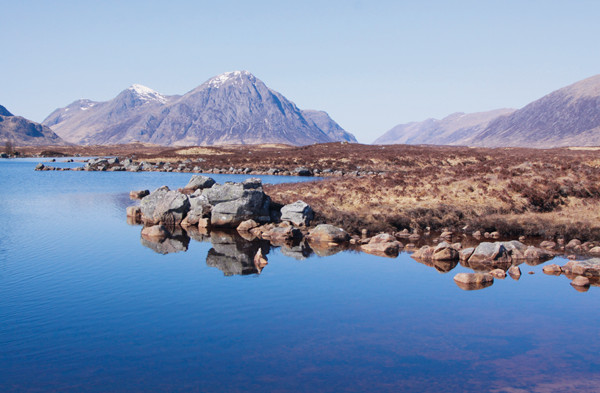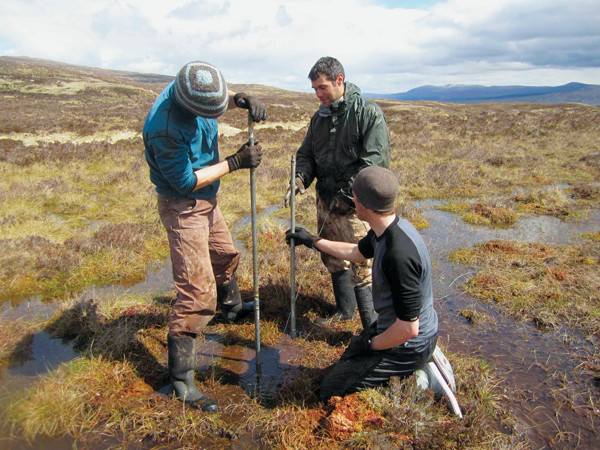
by Timothy Oleson Tuesday, November 4, 2014

The final vestiges of an ice cap from Scotland's last glaciation are thought to have melted in Rannoch Moor. Credit: Gordon Bromley.
Scotland’s craggy peaks, deep lochs and fjord-lined coast are hallmarks of a landscape shaped by successive glaciations, the last of which, toward the end of the Pleistocene, draped the highlands with an ice cap covering 9,500 square kilometers. Rocky moraines give scientists a clear picture of the boundaries of this glaciation, called the Loch Lomond Advance, although the timeline of its growth and eventual demise has proved difficult to pin down.
Between about 12,900 and 11,600 years ago, a dramatic period of climatic cooling known as the Younger Dryas sent a chill through much of the Northern Hemisphere. The Loch Lomond Advance has long been assumed to have coincided with this cold period, with the glaciation peaking at the end of the cold spell. But a new study contradicts this view, proposing instead that Scotland’s last glaciers disappeared hundreds of years earlier while the Younger Dryas was still in full swing.
To establish an end date for the Loch Lomond ice cap, researchers traveled to Scotland’s Rannoch Moor, where detailed geologic mapping and glacier models have suggested the last vestiges of Loch Lomond Advance ice would have resided. There, they collected sediment cores from moraine-dammed bogs, and then dated radiocarbon preserved in bits of organic material — mostly mosses, seeds and plant leaves — pulled from layers in the cores just above the last layer of rubble left behind by the melting glacier.

To establish when Scotland's last glaciation ended, researchers cored sediments from the moor. Credit: Gordon Bromley.
It’s a straightforward approach, says Gordon Bromley, a geologist at the University of Maine and lead author of the new study in Proceedings of the National Academy of Sciences. “You go to the last place [where glacial ice remained], and find out when the first plants began growing there.” Because they couldn’t have grown beneath the ice, the age of those early plants gives a minimum age for the end of the Loch Lomond Advance, he says.
Rather than dating to the end of the Younger Dryas, the oldest radiocarbon ages indicated that the ice cap was likely gone sometime between 12,600 and 12,200 years ago, with deglaciation leading up to its end starting even earlier, Bromley and his colleagues reported. The results counter “the paradigm that the last resurgence of glaciers in Scotland was driven by Younger Dryas cooling,” and underscore how our understanding of the Younger Dryas — the most recent example of abrupt, large-scale climate change — is still evolving, he says.
In early studies, records from pollen, ice cores and ocean sediments suggested that temperatures during the Younger Dryas were uniformly colder, but those data give annually averaged temperatures. Recently, Bromley says, there have been indications that the Younger Dryas, and other similar short-term climate episodes called “stadials,” are instead characterized more by extreme seasonality, whereby the same ocean circulation shutdown and stratification thought to cause global cooling also leads to warmer surface waters in the summer. Warming in the North Atlantic would have driven weather conditions downwind, and as glaciers are more sensitive to summer than winter conditions, this could have doomed Scotland’s last glaciers, Bromley’s team proposed.
If the new radiocarbon ages — which agree with measurements collected at Rannoch Moor in the 1970s — are accurate and considered in isolation, then the team’s “inference about the controls [on the Loch Lomond Advance] by the ocean factors would be correct,” says David Evans, a glacial geomorphologist at Durham University in England.
The problem, Evans says, is that there is “a whole raft” of other data — from cosmogenic nuclide and paleoecological studies of glacial deposits to other radiocarbon work — that paints a different picture: that Scotland’s glacial ice “was actually around until quite late on” in the Younger Dryas. In particular, he points to recent work suggesting the Loch Lomond Advance didn’t advance to its southernmost limit until after 12,000 years ago, paradoxically postdating the suggested demise of the center of the ice cap. The new research has “restated a quandary” in scientists’ understanding of the Loch Lomond Advance’s chronology “that we still need to resolve,” he says, adding that the ice cap’s behavior might have been more complicated than suggested by the study.
© 2008-2021. All rights reserved. Any copying, redistribution or retransmission of any of the contents of this service without the expressed written permission of the American Geosciences Institute is expressly prohibited. Click here for all copyright requests.